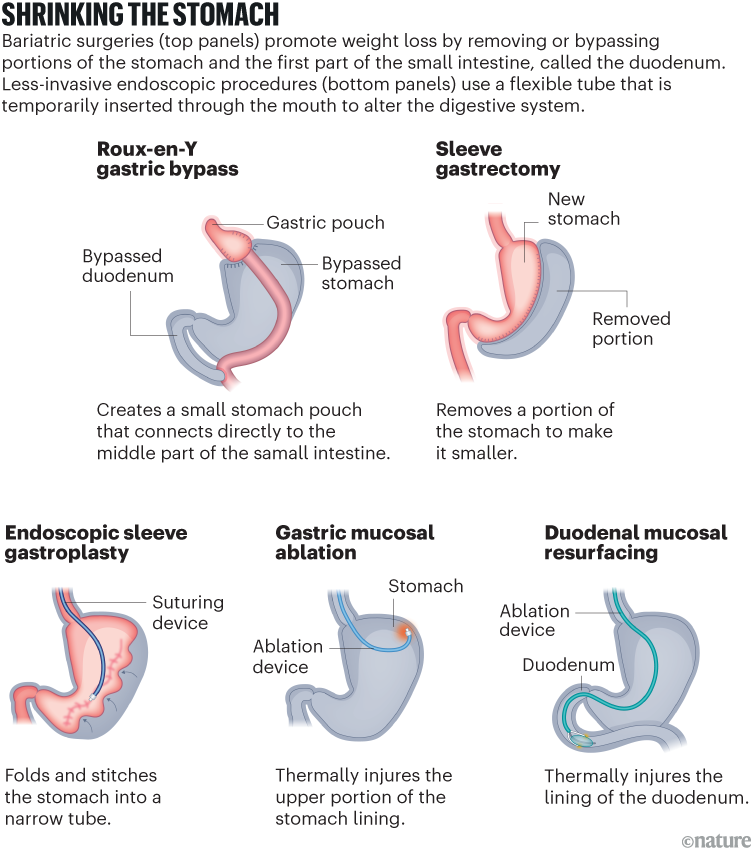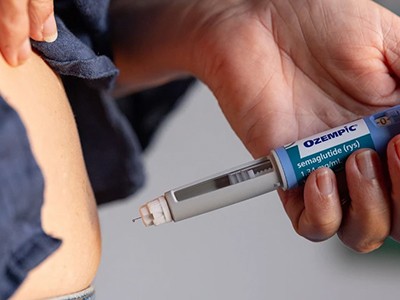Sheree had maintained a wholesome weight for 15 years, because of a surgical procedure that wrapped a silicone ring across the prime of her abdomen. However when the gastric band repeatedly slipped and needed to be eliminated, the burden got here again — quick. She gained almost 20 kilograms in simply 2 months.
Pissed off, she turned to the newest era of anti-obesity drugs, hoping to gradual the speedy weight acquire. She cycled by way of varied formulations of the blockbuster therapies semaglutide (bought beneath the model identify Wegovy) and tirzepatide (Zepbound), discovering some success with larger doses of those medicine, which mimic the consequences of the appetite-suppressing hormone GLP-1. However every time, drug shortages disrupted her therapy, forcing her to start out once more with a brand new formulation or to go with out the medicine for weeks.
Bored with the uncertainty across the therapies, she determined to attempt one thing totally different. Sheree, who requested that her center identify be used to guard her privateness, underwent two minimally invasive procedures designed to scale back the dimensions of her abdomen and to blunt starvation cues.
Dozens of recent weight problems medicine are coming: these are those to look at
Developed over the previous 20 years, these ‘endoscopic’ procedures — carried out utilizing versatile tubes inserted by way of the mouth, and no scalpels — are only one a part of a rising toolkit to assist individuals who wish to transfer away from GLP-1 remedy. Extra-conventional bariatric surgical procedures, used routinely for the reason that Eighties to reroute the stream of meals by way of the intestine or to limit the abdomen’s measurement, may additionally acquire wider attraction. And the search is choosing up for different medicine that might supply lasting options for a post-GLP-1 inhabitants.
That momentum is pushed by a convergence of things: power shortages of GLP-1 therapies, excessive prices, insurance coverage obstacles and debilitating uncomfortable side effects. In consequence, many individuals who begin the medicine finally cease — with discontinuation charges in scientific trials starting from 37% to 81% within the first yr1. And as soon as therapy ends, the burden misplaced typically piles again on.
As demand grows for complementary methods, the panorama of weight-loss therapy, which has been overtaken lately by semaglutide and tirzepatide, is now broadening once more. On this manner, says Ricardo Cohen, a weight-loss specialist on the Oswaldo Cruz German Hospital in São Paulo, Brazil, GLP-1 medicine aren’t simply reshaping therapy — they’re pulling extra folks into often-overlooked avenues of assist.
“The brand new medicine are a gateway for folks looking for weight problems care,” he says.
Surgical answer
Throughout their early ascent, GLP-1 medicine have been typically seen not as a gateway, however as a pharmaceutical repair which may render older weight-loss methods out of date.
For many years, bariatric surgical procedure had been the gold customary in weight problems care. In its varied types, together with the gastric-band surgical procedure that Sheree first had, the therapy induces substantial and sustained weight reduction and improves obesity-related well being situations. And it has a powerful security document, with charges of significant problems and mortality which can be akin to, and even decrease than, these of frequent procedures reminiscent of gallbladder removing and knee substitute.
Nonetheless, many individuals with weight problems view bariatric surgical procedure as a final resort. The proportion of eligible people who endure the procedures has remained stubbornly low — round 1% in the US, and never a lot larger in another nation.
The arrival of semaglutide and tirzepatide provided a method to attain the opposite 99% — promising to attain comparable weight reductions with out the invasiveness, restoration time or stigma typically related to surgical intervention. “The hype generated by the medicine put surgical procedure in a second tier,” acknowledges Cohen, president of the Worldwide Federation for the Surgical procedure of Weight problems and Metabolic Issues (IFSO) in Naples, Italy, a worldwide skilled group for bariatric surgeons. However he hopes to shift that notion.
In 2022, the IFSO and its US counterpart revised their tips, decreasing the advisable physique mass index thresholds for surgical procedure eligibility, aiming to make the process accessible to extra individuals who may benefit2. Cohen now sees alternatives to broaden the surgical procedure’s attain to individuals who discontinue GLP-1 remedy or who fail to attain outcomes with treatment alone — and he’s hoping to construct the case with scientific knowledge.
At his clinic in Brazil, for instance, Cohen will quickly start enrolling members for a randomized trial through which individuals who first drop a few pounds on semaglutide will probably be assigned to obtain bariatric surgical procedure, continued semaglutide injections or endure each remedies.
Tummy methods
No matter whether or not opinions of bariatric surgical procedure shift, there are different methods to shrink the abdomen. Beginning within the late 2000s, weight-loss specialists started creating non-surgical approaches that obtain comparable outcomes (see ‘Shrinking the abdomen’). As an added bonus, these methods are usually inexpensive and less complicated to deploy than are surgical strategies, as a result of they require fewer hospital sources and contain shorter restoration occasions.

Essentially the most broadly adopted has been endoscopic sleeve gastroplasty (ESG), a process carried out beneath anaesthesia that internally folds and stitches the abdomen right into a slim tube. This reduces the abdomen’s quantity by as much as 70% — to in regards to the measurement of a banana — limiting meals consumption and selling a sense of fullness, though the weight-loss outcomes are usually extra modest than with surgical procedure.
Pichamol ‘Sigh’ Jirapinyo, a bariatric endoscopist at Brigham and Girls’s Hospital in Boston, Massachusetts, says that almost half of the individuals who underwent ESG final yr at her hospital or at Bariendo, a US-based community of eight non-surgical weight-loss clinics the place she serves as medical director, had beforehand taken a GLP-1 drug. That’s up from about one in six simply two years earlier.
ESG programs are accredited as weight problems remedies in the US, the UK and past, however the process doesn’t work constantly for everybody. Sheree, who’s from North Carolina and in her 50s, learnt that first-hand in 2022. When she didn’t get the outcomes she desired from the ESG process, her doctor advisable an experimental endoscopic methodology that makes use of a medical gadget approved for different functions.
Often known as gastric mucosal ablation (GMA), the process makes use of argon gasoline and {an electrical} present to generate ionized plasma, quickly elevating tissue temperatures within the higher portion of the abdomen. The result’s a managed thermal damage that creates scar tissue alongside the gastric lining.
Vivek Kumbhari, a bariatric endoscopist at Mayo Clinic Florida in Jacksonville, and his colleagues have proven in research in rats, pigs and human tissue that this focused tissue-burning method can cut back the higher abdomen’s secretion of ghrelin, a hormone that stimulates starvation. It additionally makes the abdomen stiffer, successfully shrinking its capability (see, for instance, ref. 3).
Weight problems medicine: big research identifies new well being dangers
Early recipients of GMA, an outpatient process completed beneath anaesthesia, have skilled some uncomfortable side effects, together with cramping, nausea and bloating. However these have usually been delicate and non permanent, and are greater than offset by the weight-loss advantages, in line with Christopher McGowan, a gastroenterologist who co-founded the True You Weight Loss clinic in Cary, North Carolina.
McGowan, in collaboration with Kumbhari and others, revealed a scientific trial of GMA final yr4. The research concerned ten folks with weight problems who had tried to drop a few pounds with eating regimen and train, however explicitly excluded anybody who had taken weight-loss drugs. Now, the researchers goal to fill that hole with a trial concentrating on people who’ve discontinued GLP-1 remedy, which is extra consultant of real-world sufferers navigating a number of therapy choices. Demonstrating the effectiveness of GMA on this inhabitants may assist to influence extra physicians and potential candidates to think about the process, says McGowan — and may pave the best way for reimbursement by insurers and health-care programs.
Particular person experiences reminiscent of Sheree’s may show anecdotally persuasive, too. Months after present process GMA at McGowan’s clinic — the place she paid round US$6,000 for the process — she has reached a weight that she feels comfy with, has had no hostile reactions and is sustaining her weight with out GLP-1 medicine. “It gave me an outlet to cease chasing these medicines,” Sheree says.
Intestine reset
In a mock surgical suite in an industrial park on the outskirts of Boston, Harith Rajagopalan is testing a proprietary gadget developed explicitly for post-GLP-1 weight upkeep. When he switches it on, a slender, squid-like catheter shimmers to life. Close to the tip, a tiny balloon gently inflates with water that’s heated to near-boiling level.
This instrument, inserted endoscopically by way of the throat, creates a exactly managed tissue burn a lot as GMA does, however is focused on the duodenum, the higher portion of the small gut, slightly than the abdomen. Known as Revita, it goals to attenuate tissue injury and promote regeneration, probably rewiring how the intestine senses vitamins and regulates metabolism.
Such adjustments may reverse the hurt that power high-fat and high-sugar diets do over time, restoring “a extra regular physiologic state”, says Rajagopalan, who’s co-founder and chief govt of the agency Fractyl Well being in Burlington, Massachusetts. “The duodenum isn’t designed to see Coca-Cola and McDonald’s,” he says.

